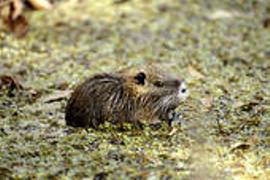Muskrats Descriptions and Habitats

Muskrats range in size from 18 to 36” long, including the 10 to 12” tail. They typically weigh between 1.5 to 4 lbs. The muskrat is classified as a rodent because of its four incisor teeth in the front of the mouth. The two upper and two lower incisors overlap, allowing them to self-sharpen as they are used. Folds of skin behind the incisors allow a submerged muskrat to cut vegetation without getting water into its mouth.
The muskrat has relatively small front feet with 4 major toes and small thumbs. Their hind feet are longer then they’re front and are partially webbed. The tail of the muskrat is deeper than it is wide and it tapers to a blunt point at the end. Their tail greatly assists in their swimming abilities.
The muskrats’ fur is short and dense. Its colors are mostly browns with lighter shades of grays or blondes on their chest and stomach areas. The under fur of the muskrat traps the air and prevents the skin of the muskrat from becoming wet while it is in the water.
Muskrats Diet
Muskrats eat mostly aquatic plants and some field crops, such as corn, soybeans, wheat, oats, sugarcane and rice grown as a flooded crop. Muskrats prefer cattails, pickerelweed, bulrushes, sedges, arrowheads, reeds, pondweeds, water lilies, and young willow. They can survive entirely on upland plants such as Bermuda grass, clover and johnsongrass, if grown near a farm pond. The will eat freshwater clams, crayfish, mussels, snails, crustaceans, small fish, turtles, and frogs when aquatic plants are scarce.
Muskrats Habitats
Muskrats are dependent upon habitats including water. This species thrives in many lakes, rivers, creeks, ponds, and marshes. Muskrats can tolerate a certain amount of pollution in water, and thus is often found living within large cities.
Muskrat Breeding
Muskrats are polygamous. Both male and female may build and maintain the den, but the female mostly cares for the young by herself. They will breed Mid March through September. Their birthing period for the first litter is April through the beginning of May, for the 2nd litter June through July (about 50% of the muskrats in our area will have a 2nd litter) and the 3rd litter (much less common) occurs in August.
Muskrats Damage and Health Hazards
Muskrats burrow in the banks of ponds, rivers and streams. Uncontrolled muskrat populations cause damage to private property and habitat. Their hole digging activities undermine earthen dams, levees and dikes completely weakening their structures. Their tunnels may drain a small farm pond. Muskrats may damage floating docks, marinas and boathouses. Large populations also cause “eat-outs.” These areas are simply over cropped by the feeding activities of the muskrats and the loss of vegetation and resulting silting makes the area less productive for other wildlife species as well. Muskrat “eat-outs” often destroy the roots of the vegetation, and it may take 15-20 years for the habitat to return to its original capacity to serve wildlife.
Muskrats are carriers of tularemia, hemorrhagic septicemia, leptospirosis salmonellosis, ringworm, pseudotuberculosis. They are hosts for many ticks, mites, fleas, and various worms.
Muskrat Removal Services
At Wildlife Busters we have years of experience in muskrat removal and muskrat trapping. We have an array of solutions that fit all types of budgets. It has been our experience, if you have had a nuisance muskrat issue in the past, you will more than likely experience a repeat nuisance wildlife removal issue. Hence we have designed, one off trapping plans, seasonal trapping plans (that come with discount renewal prices for the following season) and even prevention services. Please note that muskrat exclusion would entail bank stabilization using riprap (large rocks), a 6 -to 12-inch layer of sand or pea gravel or 1 x 2 inch mesh wire laid against the bank. Banks would be stabilized at least two feet above and three feet under the normal surface water level. As typical with all of our wildlife exclusion services, our work comes with 1 to 5 year warranties. All warranties may be renewed at the expiration with one of our long-term prevention plans. If you are experiencing an animal control issue with Muskrats, call us toll free at 1-855-945-1212.
Please note: Muskrats are considered a game species in New York State. Hence, we may trap on your premises without a permit from November 10th through April 7th. If our animal trapping and removal services are required outside of those dates, the property owner is required to obtain a permit from your regional DEC office. By law, the permit must be obtained by the property owner. We can assist you in this process.

 Receive FREE wildlife Tips!
Receive FREE wildlife Tips!
